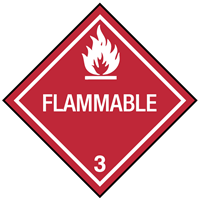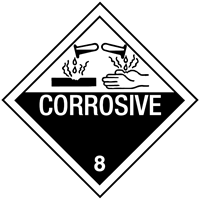
 Print
Print
Chemical Datasheet
TRIMETHYLCHLOROSILANE |


|
Chemical Identifiers
| CAS Number |
UN/NA Number |
DOT Hazard Label |
USCG CHRIS Code |
- 75-77-4

|
|
- Flammable Liquid
- Corrosive
|
|
| NIOSH Pocket Guide |
International Chem Safety Card |
|
none
|
|
NFPA 704
General Description
A colorless fuming liquid with a pungent odor. Boiling point 135°F, Flash point -18°F. Density 0.854 g / cm3. The vapor and liquid may cause burns. Vapors are heavier than air.
Hazards
Reactivity Alerts
- Highly Flammable
- Water-Reactive
- Air-Reactive
Air & Water Reactions
Highly flammable. Fumes in air. Reacts vigorously and exothermically with water. Products of the reaction include hydrogen chloride. The heat may be sufficient to ignite nearby combustible materials.
Trimethylchlorosilane reacts vigorously with water to generate gaseous HCl. Based on a scenario where the chemical is spilled into an excess of water (at least 5 fold excess of water), half of the maximum theoretical yield of Hydrogen Chloride gas will be created in 1.3 minutes. Experimental details are in the following: "Development of the Table of Initial Isolation and Protective Distances for the 2008 Emergency Response Guidebook", ANL/DIS-09-2, D.F. Brown, H.M. Hartmann, W.A. Freeman, and W.D. Haney, Argonne National Laboratory, Argonne, Illinois, June 2009.
Fire Hazard
Violent reaction with water. Toxic and irritating hydrogen chloride and phosgene may be formed in fires. Difficult to extinguish, re-ignition may occur. Flashback along vapor trail may occur. Containers may explode in fire. Vapor may explode if ignited in enclosed area. When heated to decomposition or on contact with acids or acid fumes, chloride fumes are emitted. Reacts with surface moisture, releasing hydrogen chloride, which will corrode common metals and form flammable hydrogen gas. Avoid contact with water; it readily hydrolyzes, liberating hydrochloric acid. Hazardous polymerization may not occur. (EPA, 1998)
Health Hazard
Similar to other silanes. Toxicity is rated high for inhalation, ingestion and local irritation. May cause death or permanent injury after a very short exposure to small quantities. (EPA, 1998)
Reactivity Profile
TRIMETHYLCHLOROSILANE reacts vigorously and exothermically with water to produce hydrogen chloride.
Belongs to the Following Reactive Group(s)
Potentially Incompatible Absorbents
Use caution: Liquids with this reactive group classification have been
known to react with the
absorbents
listed below.
- Cellulose-Based Absorbents
- Mineral-Based & Clay-Based Absorbents
- Dirt/Earth
Response Recommendations
Isolation and Evacuation
Excerpt from ERG Guide 155 [Substances - Toxic and/or Corrosive (Flammable / Water-Sensitive)]:
IMMEDIATE PRECAUTIONARY MEASURE: Isolate spill or leak area in all directions for at least 50 meters (150 feet) for liquids and at least 25 meters (75 feet) for solids.
SPILL: See ERG Table 1 - Initial Isolation and Protective Action Distances on the UN/NA 1298 datasheet.
FIRE: If tank, rail tank car or highway tank is involved in a fire, ISOLATE for 800 meters (1/2 mile) in all directions; also, consider initial evacuation for 800 meters (1/2 mile) in all directions. (ERG, 2024)
Firefighting
Use acid-vapor-type respirator, rubber gloves, chemical worker's goggles, and other protective equipment as necessary to protect skin and eyes.
Extinguish with dry chemicals or carbon dioxide. Do not use water or foam. Cool exposed containers with water. Water spray, fog, or foam may be required to fight large fires. However, trimethylchlorosilane may react violently with water. Do not get water inside containers. (EPA, 1998)
Non-Fire Response
Excerpt from ERG Guide 155 [Substances - Toxic and/or Corrosive (Flammable / Water-Sensitive)]:
ELIMINATE all ignition sources (no smoking, flares, sparks or flames) from immediate area. All equipment used when handling the product must be grounded. Do not touch damaged containers or spilled material unless wearing appropriate protective clothing. Stop leak if you can do it without risk. A vapor-suppressing foam may be used to reduce vapors. FOR CHLOROSILANES, use alcohol-resistant foam to reduce vapors. DO NOT GET WATER on spilled substance or inside containers. Use water spray to reduce vapors or divert vapor cloud drift. Avoid allowing water runoff to contact spilled material. Prevent entry into waterways, sewers, basements or confined areas.
SMALL SPILL: Cover with DRY earth, DRY sand or other non-combustible material followed with plastic sheet to minimize spreading or contact with rain. Use clean, non-sparking tools to collect material and place it into loosely covered plastic containers for later disposal. (ERG, 2024)
Protective Clothing
For emergency situations, wear a positive pressure, pressure-demand, full facepiece self-contained breathing apparatus (SCBA) or pressure- demand supplied air respirator with escape SCBA and a fully-encapsulating, chemical resistant suit. (EPA, 1998)
DuPont Tychem® Suit Fabrics
No information available.
First Aid
Warning: In the presence of water, trimethylchlorosilane liberates hydrochloric acid, which is extremely corrosive. Caution is advised.
Signs and Symptoms of Acute Trimethylchlorosilane Exposure: Signs and symptoms of acute trimethylchlorosilane exposure may include increased salivation, intense thirst, difficulty swallowing, chills, pain, and shock. Oral, esophageal, and stomach burns are common. Vomitus generally has a coffee-ground appearance. Acute inhalation exposure may result in hoarseness, laryngitis, a feeling of suffocation, dyspnea (shortness of breath), choking, respiratory tract irritation, chest pain, and pulmonary edema. The potential for circulatory collapse is high following ingestion of trimethylchlorosilane. Sneezing, bleeding of the nose and gums, and ulceration of the nasal and oral mucosa may also occur. Renal toxicity has been observed in animals. If the eyes come in contact with trimethylchlorosilane, irritation, pain, swelling, corneal erosion, and blindness may result. Dermal exposure is generally followed by dermatitis (red, inflamed skin), severe burns, pain, and shock.
Emergency Life-Support Procedures: Acute exposure to trimethylchlorosilane may require decontamination and life support for the victims. Emergency personnel should wear protective clothing appropriate to the type and degree of contamination. Air-purifying or supplied-air respiratory equipment should also be worn, as necessary. Rescue vehicles should carry supplies such as plastic sheeting and disposable plastic bags to assist in preventing spread of contamination.
Inhalation Exposure:
1. Move victims to fresh air. Emergency personnel should avoid self-exposure to trimethylchlorosilane.
2. Evaluate vital signs including pulse and respiratory rate, and note any trauma. If no pulse is detected, provide CPR. If not breathing, provide artificial respiration. If breathing is labored, administer oxygen or other respiratory support.
3. Obtain authorization and/or further instructions from the local hospital for administration of an antidote or performance of other invasive procedures.
4. RUSH to a health care facility.
Dermal/Eye Exposure:
1. Remove victims from exposure. Emergency personnel should avoid self- exposure to trimethylchlorosilane.
2. Evaluate vital signs including pulse and respiratory rate, and note any trauma. If no pulse is detected, provide CPR. If not breathing, provide artificial respiration. If breathing is labored, administer oxygen or other respiratory support.
3. Remove contaminated clothing as soon as possible.
4. If eye exposure has occurred, eyes must be flushed with lukewarm water for at least 15 minutes.
5. Wash exposed skin areas THOROUGHLY with soap and water.
6. Obtain authorization and/or further instructions from the local hospital for administration of an antidote or performance of other invasive procedures.
7. RUSH to a health care facility.
Ingestion Exposure:
1. Evaluate vital signs including pulse and respiratory rate, and note any trauma. If no pulse is detected, provide CPR. If not breathing, provide artificial respiration. If breathing is labored, administer oxygen or other respiratory support.
2. Rinse mouth with large amounts of water. Inform victims not to swallow this water.
3. DO NOT induce vomiting or attempt to neutralize! 4 Obtain authorization and/or further instructions from the local hospital for administration of an antidote or performance of other invasive procedures.
5. Activated charcoal is of no value.
6. Give the victims water or milk: children up to 1 year old, 125 mL (4 oz or 1/2 cup); children 1 to 12 years old, 200 mL (6 oz or 3/4 cup); adults, 250 mL (8 oz or 1 cup). Water or milk should be given only if victims are conscious and alert.
7. RUSH to a health care facility. (EPA, 1998)
Physical Properties
Flash Point:
0°F
(EPA, 1998)
Lower Explosive Limit (LEL):
1.8 %
(EPA, 1998)
Upper Explosive Limit (UEL):
39 %
(NTP, 1992)
Autoignition Temperature:
743°F
(USCG, 1999)
Melting Point:
-72°F
(EPA, 1998)
Vapor Pressure:
608 mmHg
at 68°F
; 40 mmHg at 11.5°F; 100 mmHg at 42.8°F
(NTP, 1992)
Vapor Density (Relative to Air):
3.7
(EPA, 1998)
- Heavier than air; will sink
Specific Gravity:
0.854
at 77°F
(EPA, 1998)
- Less dense than water; will float
Boiling Point:
135°F
at 760 mmHg
(EPA, 1998)
Molecular Weight:
108.66
(EPA, 1998)
Water Solubility:
Decomposes
(NTP, 1992)
Ionization Energy/Potential: data unavailable
IDLH: data unavailable
AEGLs (Acute Exposure Guideline Levels)
Final AEGLs for Trimethylchlorosilane (75-77-4)
| Exposure Period |
AEGL-1 |
AEGL-2 |
AEGL-3 |
| 10 minutes |
1.8 ppm |
100 ppm |
620 ppm |
| 30 minutes |
1.8 ppm |
43 ppm |
210 ppm |
| 60 minutes |
1.8 ppm |
22 ppm |
100 ppm |
| 4 hours |
1.8 ppm |
11 ppm |
26 ppm |
| 8 hours |
1.8 ppm |
11 ppm |
26 ppm |
(NAC/NRC, 2024)
ERPGs (Emergency Response Planning Guidelines)
| Chemical |
ERPG-1 |
ERPG-2 |
ERPG-3 |
| Silane, Trimethylchloro- (75-77-4)
|
3 ppm  |
20 ppm |
150 ppm |
(AIHA, 2022)
PACs (Protective Action Criteria)
| Chemical |
PAC-1 |
PAC-2 |
PAC-3 |
|
| Trimethylchlorosilane (75-77-4)
|
1.8 ppm |
22 ppm |
100 ppm |
LEL = 18000 ppm |
(DOE, 2024)
Regulatory Information
EPA Consolidated List of Lists
| Regulatory Name |
CAS Number/
313 Category Code |
EPCRA 302
EHS TPQ |
EPCRA 304
EHS RQ |
CERCLA RQ |
EPCRA 313
TRI |
RCRA
Code |
CAA 112(r)
RMP TQ |
| Silane, chlorotrimethyl- |
75-77-4 |
1000 pounds |
1000 pounds |
|
|
|
10000 pounds |
| Trimethylchlorosilane |
75-77-4 |
1000 pounds |
1000 pounds |
|
|
|
10000 pounds |
(EPA List of Lists, 2024)
CISA Chemical Facility Anti-Terrorism Standards (CFATS)
|
RELEASE |
THEFT |
SABOTAGE |
| Chemical of Interest |
CAS Number |
Min Conc |
STQ |
Security
Issue |
Min Conc |
STQ |
Security
Issue |
Min Conc |
STQ |
Security
Issue |
| Trimethylchlorosilane; [Silane, chlorotrimethyl-] |
75-77-4 |
1.00 % |
10000 pounds |
flammable |
|
|
|
ACG |
APA |
sabotage/ contamination |
(CISA, 2007)
OSHA Process Safety Management (PSM) Standard List
No regulatory information available.
Alternate Chemical Names
- CHLOROTRIMETHYLSILANE
- CHLOROTRIMETHYLSILICANE
- KA 31
- MONOCHLOROTRIMETHYLSILANE
- MONOCHLOROTRIMETHYLSILICON
- SILANE, CHLOROTRIMETHYL-
- SILANE, TRIMETHYLCHLORO-
- SILICANE, CHLOROTRIMETHYL
- SILYLIUM, TRIMETHYL-, CHLORIDE
- TL 1163
- TRIMETHYL CHLOROSILANE
- TRIMETHYLCHLOROSILANE
- TRIMETHYLSILANE CHLORIDE
- TRIMETHYLSILICON CHLORIDE
- TRIMETHYLSILYL CHLORIDE
- TSL 8031



 Print
Print

